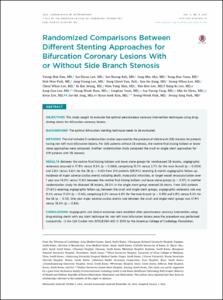KUMEL Repository
1. Journal Papers (연구논문)
1. School of Medicine (의과대학)
Dept. of Internal Medicine (내과학)
Randomized Comparisons Between Different Stenting Approaches for Bifurcation Coronary Lesions With or Without Side Branch Stenosis
- Affiliated Author(s)
- 남창욱
- Alternative Author(s)
- Nam, Chang Wook
- Journal Title
- JACC: Cardiovascular Interventions
- ISSN
- 1936-8798
- Issued Date
- 2015
- Keyword
- bifurcation; coronary artery disease; restenosis; stent
- Abstract
- Objectives:
This study sought to evaluate the optimal percutaneous coronary intervention techniques using drug-eluting stents for bifurcation coronary lesions.
Background
:
The optimal bifurcation stenting technique needs to be evaluated.
Methods:
The trial included 2 randomization studies separated by the presence of side branch (SB) stenosis for patients having non–left main bifurcation lesions. For 306 patients without SB stenosis, the routine final kissing balloon or leave-alone approaches were compared. Another randomization study compared the crush or single-stent approaches for 419 patients with SB stenosis.
Results:
Between the routine final kissing balloon and leave-alone groups for nondiseased SB lesions, angiographic restenosis occurred in 17.9% versus 9.3% (p = 0.064), comprising 15.1% versus 3.7% for the main branch (p = 0.004) and 2.8% versus 5.6% for the SB (p = 0.50) from 214 patients (69.9%) receiving 8-month angiographic follow-up. Incidence of major adverse cardiac events including death, myocardial infarction, or target vessel revascularization over 1 year was 14.0% versus 11.6% between the routine final kissing balloon and leave-alone groups (p = 0.57). In another randomization study for diseased SB lesions, 28.2% in the single-stent group received SB stents. From 300 patients (71.6%) receiving angiographic follow-up, between the crush and single-stent groups, angiographic restenosis rate was 8.4% versus 11.0% (p = 0.44), comprising 5.2% versus 4.8% for the main branch (p = 0.90) and 3.9% versus 8.3% for the SB (p = 0.12). One-year major adverse cardiac events rate between the crush and single-stent groups was 17.9% versus 18.5% (p = 0.84).
Conclusions:
Angiographic and clinical outcomes were excellent after percutaneous coronary intervention using drug-eluting stents with any stent technique for non–left main bifurcation lesions once the procedure was performed successfully.
- Department
- Dept. of Internal Medicine (내과학)
- Publisher
- School of Medicine
- Citation
- Young-Hak Kim et al. (2015). Randomized Comparisons Between Different Stenting Approaches for Bifurcation Coronary Lesions With or Without Side Branch Stenosis. JACC: Cardiovascular Interventions, 8(4), 550–560. doi: 10.1016/j.jcin.2015.01.016
- Type
- Article
- ISSN
- 1936-8798
- Appears in Collections:
- 1. School of Medicine (의과대학) > Dept. of Internal Medicine (내과학)
- 파일 목록
-
-
Download
 oak-aaa-2644.pdf
기타 데이터 / 762.09 kB / Adobe PDF
oak-aaa-2644.pdf
기타 데이터 / 762.09 kB / Adobe PDF
-
Items in Repository are protected by copyright, with all rights reserved, unless otherwise indicated.